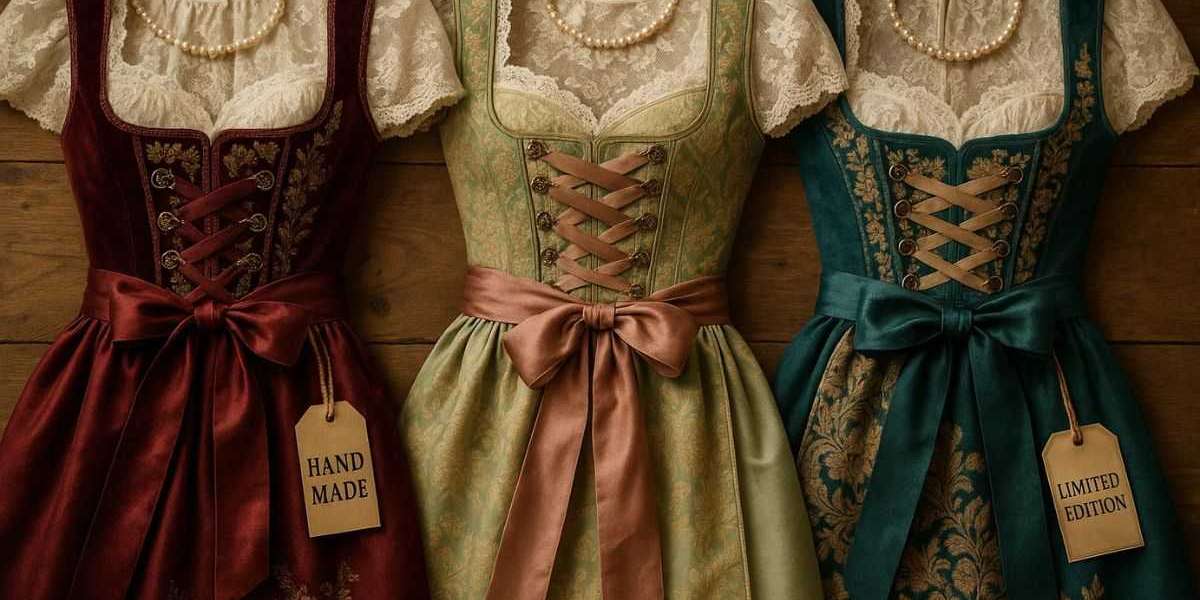Introduction: The Dirndl – A Symbol of Bavarian Heritage
The Dirndl dress, with its elegant bodice, flowing skirt, and apron, is more than just attire—it's a cultural statement steeped in history. Originating from Alpine regions, Dirndls have become a fashion staple for Oktoberfest and other traditional festivals. However, many people are taken aback by the price tags attached to these outfits. So, what justifies their cost? In this detailed post, we’ll break down the 6 major reasons why Dirndl dresses are expensive and help you understand what you’re paying for when investing in one.
1. Handcrafted Detailing and Stitching
One of the main contributors to the high price of a Dirndl is its handcrafted nature. Unlike mass-produced dresses, many Dirndls are handmade with attention to detail. The embroidery, lace trimming, and ruffled collars are crafted meticulously, often by skilled artisans. This not only enhances the aesthetic but also adds to the dress’s durability.
For a closer look at handcrafted traditional wear, visit this collection of authentic German attire.
2. Premium Quality Fabrics
A true Dirndl is not made from ordinary material. These dresses often use premium textiles such as silk, satin, velvet, and high-thread-count cotton. Such luxurious fabrics do not come cheap and are chosen not just for beauty but also for comfort and longevity.
Each layer—from bodice to apron—is designed to drape elegantly while being breathable and durable. This is a major upgrade from the synthetic materials used in costume versions.
3. Traditional Design and Authenticity
Another factor in the cost is the design authenticity. Real Dirndls are inspired by traditional Bavarian and Austrian patterns that have been preserved for generations. These designs hold cultural significance and are deeply rooted in heritage, which adds intrinsic value.
If you’re curious about such traditional styling, explore their background through this in-depth article.
4. Limited Production and Custom Fitting
Dirndls are not mass-produced like typical dresses. Many are made in small batches or even custom-stitched, tailored to fit specific body types. This limited production guarantees exclusivity and a better fit.
A made-to-measure Dirndl ensures flattering curves, proper bust support, and a tailored waist—features that cheap, off-the-rack versions lack.
5. Embellishments and Accessories
High-end Dirndls come with embellishments such as embroidered aprons, pearl buttons, and hand-sewn ribbon lacing. Accessories like matching blouses, shawls, or chokers also add to the overall cost.
These extras are more than decorations—they are integral parts of the outfit that maintain cultural integrity and enhance the look. Many of them are handmade or sourced from specialized suppliers.
6. Cultural and Seasonal Demand
Finally, the cultural significance and seasonal popularity play a key role in pricing. With major festivals like Oktoberfest driving demand, prices naturally spike during the season. Moreover, owning a Dirndl is often a one-time or rare purchase, which means brands emphasize quality over quantity.
For women seeking premium festival wear, this women’s collection is an excellent place to start looking for outfits that balance style, comfort, and tradition.
How to Choose the Right Dirndl for Your Budget
When shopping for a Dirndl, consider what features are most important to you. Are you seeking authenticity, comfort, or modern flair? Set a realistic budget but also remember that a well-made Dirndl can last for years, making it a worthwhile investment.
Compare materials, stitching, and reviews to ensure you’re not compromising on value.
Caring for Your Dirndl: Make It Last
To maintain the quality of your Dirndl, it’s important to care for it properly. Always check the label for cleaning instructions—most premium Dirndls are dry-clean only. Store them in breathable garment bags, and avoid exposing them to direct sunlight for long periods.
The Difference Between Costume and Authentic Dirndl
It’s essential to understand the difference between a costume Dirndl and an authentic one. Costume versions are cheaper, often made of polyester, and lack the details of traditional wear. While they may suffice for casual events, they don’t carry the same prestige or comfort.
Why Investing in a Dirndl Is Worth It
Despite the upfront cost, investing in a Dirndl pays off in the long run. It offers durability, elegance, and cultural pride. Whether for festivals, weddings, or photo shoots, a high-quality Dirndl is both fashionable and symbolic.
Modern vs. Traditional Dirndls
The fashion world has also welcomed modern variations of Dirndls—shorter lengths, pastel colors, and minimalist designs. While these versions may not be historically accurate, they cater to evolving style preferences without compromising craftsmanship.
Is Buying Online a Good Option?
Buying online can be a great way to access quality Dirndls, especially from reputed stores that specialize in traditional German attire. Look for websites with customer reviews, detailed product descriptions, and clear return policies.
Sustainable Fashion and Dirndl Production
Many modern brands now focus on eco-friendly practices, using organic cotton and sustainable manufacturing methods. This adds to the cost but ensures that the dress is made ethically and responsibly.
Tips for First-Time Buyers
If you’re purchasing your first Dirndl, follow these tips:
Measure yourself accurately
Choose a versatile color
Start with a mid-range option
Pair with neutral accessories
Don’t rush—research well to ensure you’re making a smart purchase that reflects your style and values.
Conclusion: Paying for Heritage and Craftsmanship
Dirndl dresses may be expensive, but they are more than just garments. You’re paying for artistry, cultural legacy, and personalized beauty. With the right care, they can remain wardrobe treasures for years.
FAQs
1. Are Dirndls always handmade?
Not always, but premium Dirndls often involve handcrafting in parts such as embroidery and stitching.
2. Can I wash my Dirndl at home?
It depends on the fabric. Many require dry-cleaning due to delicate materials.
3. Why are festival Dirndls more costly?
Festival-ready Dirndls often feature higher-end fabrics and traditional embellishments, justifying the price.
4. What’s the difference between a cheap and expensive Dirndl?
Material quality, fit, and craftsmanship are key differentiators.
5. Are Dirndls suitable for all body types?
Yes! With the right fit and cut, they flatter various shapes and sizes.
6. Is it better to buy online or in-store?
Both options work well if you’re buying from reputable sources with clear sizing and return policies.













